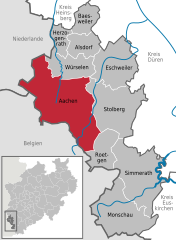
Back Aken Afrikaans Aachen ALS አኽን Amharic Aquisgrán AN آخن Arabic اخين ARZ Aquisgrán AST Aachen AVK Aaxen Azerbaijani آخن AZB
Aachen
Oche (Aachen dialect) | |
|---|---|
Choir and apse with Shrine of Mary | |
Location of Aachen within Städteregion Aachen  | |
| Coordinates: 50°46′32″N 06°05′01″E / 50.77556°N 6.08361°E | |
| Country | Germany |
| State | North Rhine-Westphalia |
| Admin. region | Cologne |
| District | Aachen |
| Government | |
| • Lord mayor (2020–25) | Sibylle Keupen[1] (Ind.) |
| • Governing parties | The Greens / SPD [2] |
| Area | |
| • Total | 160.85 km2 (62.10 sq mi) |
| Elevation | 173 m (568 ft) |
| Population (2023-12-31)[3] | |
| • Total | 252,769 |
| • Density | 1,600/km2 (4,100/sq mi) |
| Time zone | UTC+01:00 (CET) |
| • Summer (DST) | UTC+02:00 (CEST) |
| Postal codes | 52062–52080 |
| Dialling codes | 0241 / 02405 / 02407 / 02408 |
| Vehicle registration | AC / MON |
| Website | aachen |

Aachen (/ˈɑːkən/ AH-kən, German: [ˈaːxn̩] ; Aachen dialect: Oche [ˈɔːxə]; Dutch: Aken [ˈaːkə(n)] ; French: Aix-la-Chapelle;[a] Latin: Aquae Granni or Aquisgranum) is the 13th-largest city in North Rhine-Westphalia and the 27th-largest city of Germany, with around 261,000 inhabitants.[4]
Aachen is located at the northern foothills of the High Fens and the Eifel Mountains. It sits on the Wurm River, a tributary of the Rur, and together with Mönchengladbach, it is the only larger German city in the drainage basin of the Meuse. It is the westernmost larger city in Germany, lying approximately 61 km (38 mi) west of Cologne and Bonn, directly bordering Belgium in the southwest, and the Netherlands in the northwest. The city lies in the Meuse–Rhine Euroregion and is the seat of the district of Aachen (Städteregion Aachen).
The once Celtic settlement was equipped with several thermae in the course of colonization by Roman pioneers settling at the warm Aachen thermal springs around the 1st century. After the withdrawal of the Roman troops, the vicus Aquae Granni was Frankized around the 5th century. This was followed by a period of sedentism under first Merovingian and then Carolingian rule. With the completion of the Carolingian Palace of Aachen at the transition to the 9th century, Aachen was constituted as the main royal residence of the Frankish Empire ruled by Charlemagne. Because of that the city is sometimes called "cradle of Europe".[5] After the Treaty of Verdun, the city was within the borders of Middle Francia, until it became part of East Francia after the Treaty of Meerssen (870). It subsequently was part of the Holy Roman Empire and was granted city rights in 1166 by Emperor Frederick Barbarossa, becoming an imperial city. It served as the coronation site where 31 Holy Roman Emperors were crowned Kings of the Germans from 936 to 1531, until Frankfurt am Main became the preferred place of coronation.
One of Germany's leading institutes of higher education in technology, the RWTH Aachen University (Rheinisch-Westfälisch Technische Hochschule Aachen), is located in the city. Its university hospital Uniklinikum Aachen is Europe's largest single-building hospital. Aachen's industries include science, engineering and information technology. In 2009, Aachen was ranked eighth among cities in Germany for innovation.
The regional dialect spoken in the city is a Central Franconian, Ripuarian variant with strong Limburgish influences from the dialects in the neighbouring Netherlands. As a Rhenish city, Aachen is one of the main centres of carnival celebrations in Germany, along with Cologne and Mainz. The culinary specialty for which the city is best known is Aachener Printen, a type of gingerbread.
- ^ Wahlergebnisse in NRW Kommunalwahlen 2020 Archived 17 May 2022 at the Wayback Machine, Land Nordrhein-Westfalen, accessed 19 June 2021.
- ^ Peltzer, Albrecht (28 October 2022). "Koalitionsvertrag: Grüne und Rote geben jetzt in Aachen die Richtung vor". Aachener Zeitung. Archived from the original on 27 March 2023. Retrieved 28 February 2023.
- ^ "Bevölkerung der Gemeinden Nordrhein-Westfalens am 31. Dezember 2023 – Fortschreibung des Bevölkerungsstandes auf Basis des Zensus vom 9. Mai 2011" (in German). Landesbetrieb Information und Technik NRW. Retrieved 20 June 2024.
- ^ "Zensus 2022: Stadt Aachen gewinnt 10.941 Einwohner*innen – 06/25/2024". aachen.de.
- ^ "City Portrait Aachen – DW – 04/27/2007". dw.com.
Cite error: There are <ref group=lower-alpha> tags or {{efn}} templates on this page, but the references will not show without a {{reflist|group=lower-alpha}} template or {{notelist}} template (see the help page).











